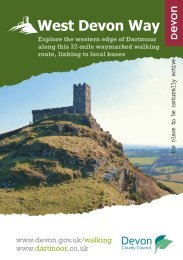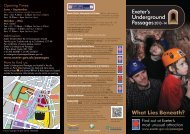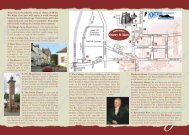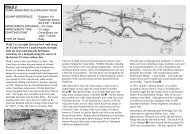Medieval Trail Leaflet - Exeter City Council
Medieval Trail Leaflet - Exeter City Council
Medieval Trail Leaflet - Exeter City Council
You also want an ePaper? Increase the reach of your titles
YUMPU automatically turns print PDFs into web optimized ePapers that Google loves.
<strong>Medieval</strong> <strong>Exeter</strong><br />
The Middle Ages were a period of rapid<br />
growth for <strong>Exeter</strong>. It became the religious,<br />
commercial, and administrative centre for<br />
the region. Throughout the period following<br />
the Norman Conquest in 1066 until the reign<br />
of Henry Tudor in 1485 (Henry VII), a<br />
complex relationship between the Crown,<br />
Cathedral and <strong>City</strong> developed.<br />
Find out more about<br />
<strong>Medieval</strong> <strong>Exeter</strong><br />
Join a guided tour of <strong>Medieval</strong><br />
<strong>Exeter</strong> with <strong>Exeter</strong>’s Red Coat<br />
Guides. For more information<br />
call 01392 265203.<br />
<strong>Exeter</strong>’s Heritage Attractions include:<br />
<strong>Exeter</strong> Cathedral: One of the finest examples of<br />
the decorated Gothic style in the country.<br />
Tel. 01392 285983<br />
Quay House Visitor Centre: Discover <strong>Exeter</strong>’s<br />
2000-year history with a fascinating film show.<br />
Tel. 01392 271611<br />
<strong>Exeter</strong>’s Underground Passages: Explore beneath<br />
the streets of <strong>Exeter</strong> through these vaulted<br />
medieval passages.<br />
Tel. 01392 665887<br />
<strong>Exeter</strong><br />
<strong>Medieval</strong> <strong>Trail</strong><br />
Visit <strong>Exeter</strong> <strong>City</strong> <strong>Council</strong>’s Time <strong>Trail</strong> at<br />
www.rammtimetrail.org.uk and discover more<br />
about the medieval period and <strong>Exeter</strong> in general.<br />
Have you enjoyed this trail<br />
Why not weave your way<br />
through <strong>Exeter</strong>’s industrial past on<br />
‘The <strong>Exeter</strong> Woollen <strong>Trail</strong>’. Explore<br />
the key sites involved in <strong>Exeter</strong>’s<br />
woollen cloth industry.<br />
Explore many of the key sites of <strong>Exeter</strong>’s<br />
most important industry<br />
of the past, the woollen cloth trade.<br />
Red Coat Guided Tours: To find out more about<br />
<strong>Exeter</strong>’s rich history and heritage why not join one<br />
of a number of free guided tours.<br />
Tel. 01392 265203<br />
Guildhall: Dating from 1330 <strong>Exeter</strong>’s Guildhall is<br />
one of England’s oldest municipal buildings.<br />
Tel. 01392 665500<br />
St. Nicholas Priory - A Tudor Home: Tudor life in<br />
the heart of the <strong>City</strong> .<br />
Tel. 01392 665858<br />
Tuckers Hall: The medieval guildhall of the only<br />
surviving trades guild in <strong>Exeter</strong>, the incorporation<br />
of Weavers, Fullers and Shearmen.<br />
Tel. 01392 412348<br />
Self Guided Walk<br />
Using this leaflet, guide yourself to<br />
8 information panels. At each site find out<br />
about the buildings of medieval <strong>Exeter</strong> and<br />
key events that affected the people during<br />
this time. For children there are quizzes and<br />
puzzles to solve along the way so bring<br />
paper and a pencil with you.<br />
You can also explore many of<br />
the key events in <strong>Exeter</strong>’s past on<br />
‘The <strong>City</strong> Wall <strong>Trail</strong>’. Discover how<br />
this wall, which is almost 2000<br />
years old, is linked with the city’s<br />
past, having repelled rebellions, as<br />
well as being the scene for many<br />
civic ceremonies.<br />
<strong>City</strong> Wall<br />
<strong>Trail</strong> leaflets are available from <strong>Exeter</strong> Visitor<br />
Information & Tickets and the Quay House<br />
Visitor Centre. Their locations are indicated on<br />
the map overleaf.<br />
The<br />
<strong>Trail</strong><br />
Self-Guided Walk<br />
Discover the history of <strong>Exeter</strong>’s <strong>City</strong> Wa l<br />
and the key events that have occurred<br />
throughout its past.<br />
For information about <strong>Exeter</strong> contact<br />
<strong>Exeter</strong> Visitor Information & Tickets, Dix’s Field,<br />
<strong>Exeter</strong> EX1 1GF<br />
Tel: 01392 665700<br />
Email: evit@exeter.gov.uk www.exetershopping.org<br />
www.exeterandessentialdevon.com<br />
Printed on<br />
recycled paper<br />
Photography by Angelo Hornak, Gary Young, <strong>Exeter</strong> <strong>City</strong> <strong>Council</strong>,<br />
<strong>Exeter</strong> Cathedral & Stonefree Photography<br />
30k 2010<br />
Discover <strong>Exeter</strong>’s medieval past, find<br />
out about many of <strong>Exeter</strong>’s surviving<br />
gems and the events that helped to<br />
shape this period of <strong>Exeter</strong>’s past.<br />
Designed & produced by Meridian Print & Marketing Ltd
I<br />
Castle Street<br />
The medieval period was one of growth for <strong>Exeter</strong>.<br />
In this time it established itself as the<br />
administrative, economic and ecclesiastic centre for<br />
the region. Within the city there is still much<br />
evidence of <strong>Exeter</strong>’s medieval past, which can be<br />
further explored on this trail.<br />
From here<br />
return to the<br />
High Street, turn<br />
right and<br />
continue along<br />
it until you<br />
reach Martin’s<br />
Lane (fourth<br />
turning on the<br />
left). Continue to<br />
the end of<br />
Martin’s Lane<br />
<strong>Exeter</strong> Cathedral<br />
and turn right<br />
onto Cathedral Yard. At the end of Cathedral Yard<br />
you will see St. Petrock’s Church on your right, it is<br />
here you will discover more about:<br />
2<br />
The Cathedral Church<br />
of St. Peter<br />
Start your walk on<br />
Castle Street, just<br />
off the High Street.<br />
From here cross Cathedral Green on the path that<br />
runs along the left hand side of the Cathedral (stop to<br />
look at the Cathedral West Front). Turn right at the<br />
end and continue under the small iron bridge to the<br />
end of the cobbled street. Turn right and head<br />
towards the Southgate Hotel to discover more about<br />
the history of this area:<br />
3<br />
Southernhay<br />
<strong>Exeter</strong> was a flourishing centre of trade, as well as an<br />
important player in the woollen cloth industry. The<br />
city held important fairs and was the home to several<br />
weekly markets. This area was once home to the<br />
Lammas Fair.<br />
Cross the road onto<br />
Southernhay East, turn<br />
right and walk to the<br />
end of the street. Turn<br />
left onto Magdalen<br />
Street and after 100<br />
metres you will be at<br />
Wynards Almshouses<br />
(The panel is located on the railing of the driveway):<br />
4<br />
Wynard’s Almshouses<br />
In the Middle Ages care for the sick and elderly was<br />
provided either by the church or financed by wealthy<br />
merchants. These Almshouses dating from<br />
1435, were built by William Wynard, (recorder<br />
of the <strong>City</strong>) to house 12 infirm people.<br />
Walk back along Magdalen Street and turn<br />
right into South Street. Cross the road using<br />
the pelican crossing by Palace Gate, turn right<br />
and then left onto Market Street. Follow the<br />
road round then take the second turning on<br />
the left onto Smythen Street. Continue to the<br />
car park:<br />
5<br />
Smythen Street<br />
Wynard’s<br />
Almshouses<br />
The street layout of this area remains very<br />
similar to how it would have been in<br />
medieval times. In this period workers of one<br />
trade or profession would often live in the<br />
same street, giving the street its name.<br />
Return to Market Street, turn left and then<br />
right onto Fore Street. In the alley way on the<br />
right hand side between the shops (Milk<br />
Street) find out about:<br />
Return to Fore Street, turn<br />
right and cross South Street,<br />
head towards the gap<br />
between the shops and<br />
discover the intriguing story<br />
about:<br />
7<br />
The Gates to<br />
the Close<br />
For over 500 years entry to<br />
the Cathedral Precinct would<br />
have been controlled by seven gates.<br />
The gates were erected following the murder of a<br />
member of the Cathedral clergy.<br />
Continue along Cathedral Yard and at St Martin’s<br />
Church walk straight ahead towards Catherine<br />
Square. Just past the raised area turn left and head<br />
for St. Stephen’s Bow just behind the church:<br />
8<br />
St. Stephen’s House<br />
Underground Passages<br />
Behind you is St. Stephen’s Church, which dates from<br />
the 11th Century. <strong>Exeter</strong> became a major ecclesiastic<br />
centre in the Middle Ages, not only was there a<br />
Cathedral, but within the city there were 32 parish<br />
churches, and in and around the area there were<br />
7 monastic houses.<br />
The Cathedral is the jewel in <strong>Exeter</strong>’s crown. The<br />
area has been used as a place of worship since the<br />
4th Century and eventually a Saxon Abbey was<br />
built. The Abbey became a Cathedral in 1050. From<br />
1114 a new Cathedral was constructed, and in the<br />
13th and 14th centuries the Cathedral was rebuilt<br />
in the decorated Gothic architectural style.<br />
6<br />
The Carfax<br />
In the Middle Ages, unlike most cities, <strong>Exeter</strong><br />
had the luxury of a piped fresh supply of<br />
drinking water. In this area there used to be<br />
one of the public water fountains known as<br />
the Great Conduit<br />
St Nicholas Priory
















